The Ussr Will Rise Again in Russian
Soviet Russia
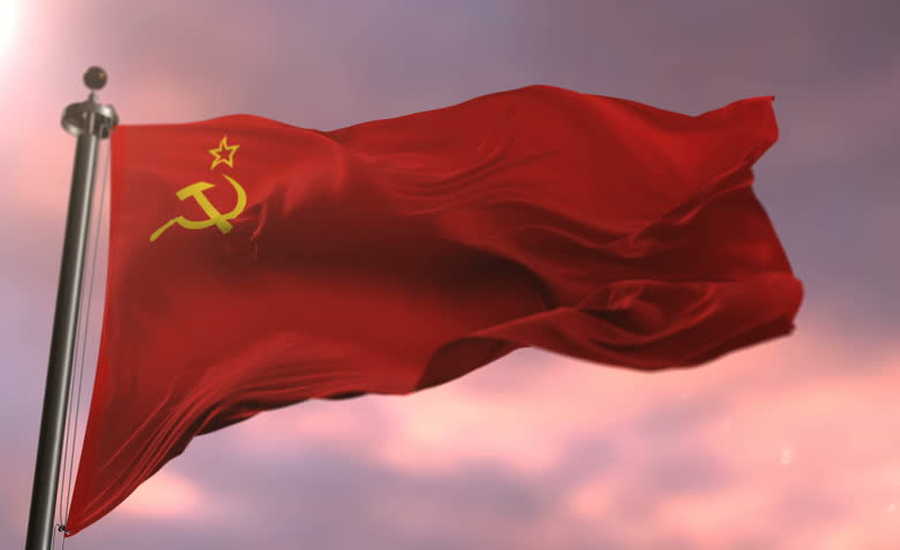
How did life change in Soviet Russian federation?
- The Soviet Spousal relationship with Moscow as its new erstwhile uppercase was founded in December 1922 and received its constitution in 1924.
- Social life changed radically. Women gained more rights in an attempt to become rid of the patriarchy and the influence of the church was weakened.
- Post-obit Lenin's decease in 1924 and the establishment of Stalin equally the new leader of the Spousal relationship, the procedure of industrialization and collectivization was speedily gear up in motion.
- Anybody who was opposed to Stalin was liquidated. Citizens were accused of sabotage and espionage and sent to labor camps – the so-chosen Gulags – in Siberia, which played a vital office in the country's industrialization efforts.
- Subsequently Stalin died, Krushchev introduced reforms to increase the product of consumer goods. He also tackled the notorious housing problem and stimulated the agriculture, thus greatly improving the standard of living in the USSR.
- The Soviet Union finally bankrupt apart in 1991, in the wake of Gorbachevs failed reformation attempts.
Creation of the Soviet Union
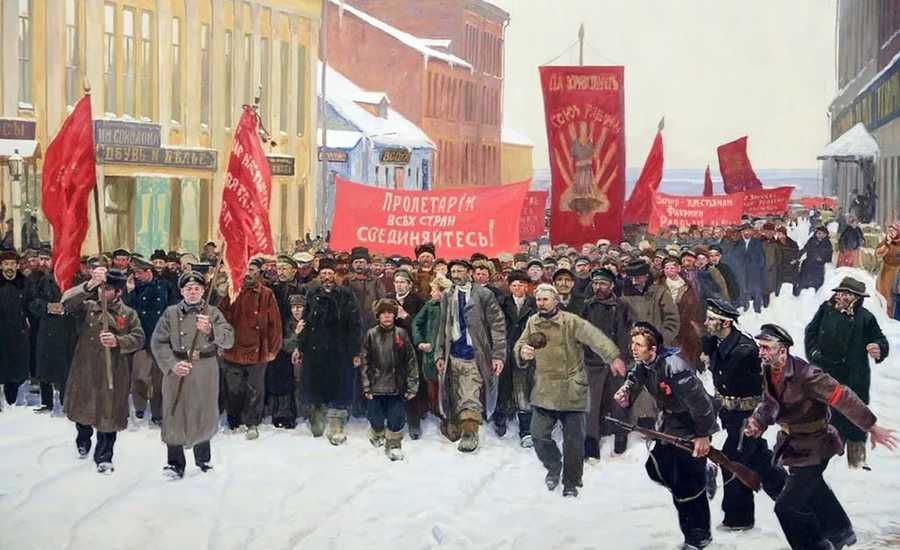
The history of Russia betwixt 1922 and 1991 is essentially the history of the Wedlock of Soviet Socialist Republics or the Soviet Matrimony. This ideologically-based union, established in Dec 1922 by the leaders of the Russian Communist Party, was roughly coterminous with the Russian Empire. At that time, the new nation included four elective republics: the Russian SFSR, the Ukrainian SSR, Belorussian SSR, and the Transcaucasian SFSR.
The constitution, adopted in 1924, established a federal system of government based on a succession of soviets set in villages, factories, and cities in larger regions. This pyramid of soviets in each constituent republic culminated in the All-Union Congress of Soviets. But while it appeared that the congress exercised sovereign power, this body was actually governed past the Communist Party, which in turn was controlled past the Politburo from Moscow, the uppercase of the Soviet Wedlock, just every bit it had been under the tsars before Peter the Keen.
War comunism and the New Economic Policy
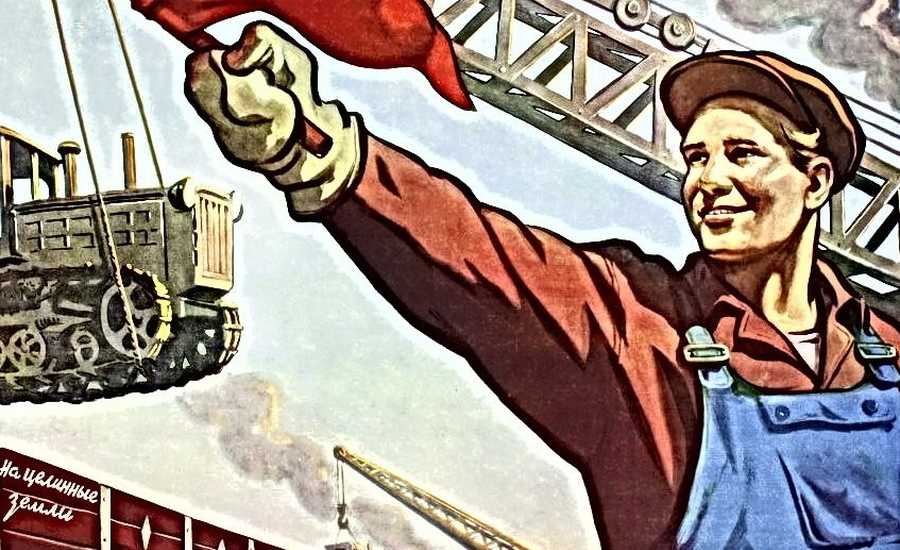
The menses from the consolidation of the Bolshevik Revolution in 1917 until 1921 is known as the flow of war communism. Banks, railroads, and shipping were nationalized and the money economic system was restricted. Strong opposition soon developed. The peasants wanted greenbacks payments for their products and resented having to surrender their surplus grain to the authorities as a part of its civil war policies. Confronted with peasant opposition, Lenin began a strategic retreat from war communism known every bit the New Economical Policy (NEP). The peasants were freed from wholesale levies of grain and allowed to sell their surplus produce in the open market place. Commerce was stimulated by permitting private retail trading. The state connected to be responsible for cyberbanking, transportation, heavy industry, and public utilities.
Although the left opposition among the Communists criticized the rich peasants or kulaks, who benefited from the NEP, the program proved highly beneficial and the economy revived. The NEP would later come under increasing opposition from within the party following Lenin's expiry in early 1924.
Changes in Russian order
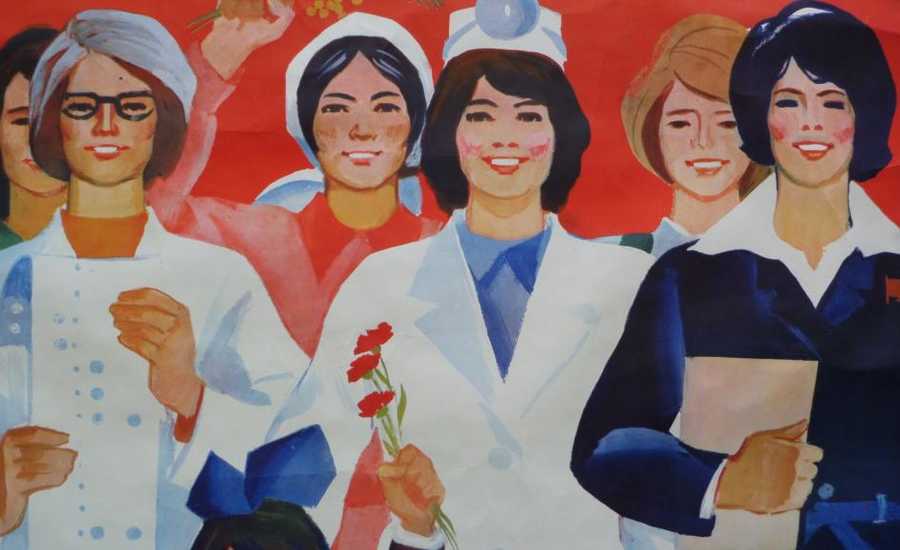
While the Russian economy was being transformed, the social life of the people underwent as drastic changes. From the outset of the revolution, the government attempted to weaken patriarchal domination of the family. Divorce no longer required court procedure, and to make women completely free of the responsibilities of childbearing, abortion was made legal as early as 1920. The emancipation of the women increased the labor market. Girls were encouraged to secure an education and pursue a career in the factory or the office. Communal nurseries were set upward for the care of pocket-size children, and efforts were made to shift the center of people'due south social life from the domicile to educational and recreational groups, the soviet clubs.
The regime abandoned the tsarist policy of discriminating against national minorities in favor of a policy of incorporating the more than two hundred minority groups into Soviet life. Another feature of the regime was the extension of medical services. Campaigns were carried out against typhus, cholera, and malaria; the number of doctors was increased as chop-chop every bit facilities and training would allow; and infant bloodshed rates quickly decreased while life expectancy chop-chop increased.
The government also promoted atheism and materialism, which formed the basis of Marxist theory. It opposed religion, specially in guild to break the power of the Russian Orthodox Church, a former pillar of the old tsarist regime and a major barrier to social alter. Many religious leaders were sent to internal exile camps. Members of the party were forbidden to attend religious services. The pedagogy system was separated from the Church building. Religious instruction was prohibited except in the home and atheist educational activity was stressed in the schools.
Industrialization and collectivization

The years from 1929 to 1939 comprised a tumultuous decade in Russian history - a menses of massive industrialization and internal struggles. At this fourth dimension Joseph Stalin established near total control over Russian society, wielding unrestrained power unknown to even the about ambitious tsars. Following Lenin'due south death Stalin wrestled for control of the Soviet Union with rival factions in the Politburo, especially Leon Trotsky's. By 1928, with the Trotskyites either exiled or rendered powerless, Stalin was ready to put a radical plan of industrialization into action.
In 1928 Stalin proposed the get-go V-Year Program and abolished the NEP. The start 5-Year Plan was the first of a number of plans aimed at swift aggregating of majuscule resources though the buildup of heavy industry, the collectivization of agronomics, and the restricted manufacture of consumer goods. With the implementation of the program, for the first time in history a government controlled all economic activity. While in the backer countries factories and mines were idle or running on reduced schedules during the Dandy Depression and millions were unemployed, the Soviet people worked many hours a mean solar day, vi days a week, in a thoroughgoing attempt to revolutionize Russia'southward economic structure.
As a part of the programme, the regime took control of agriculture through the land and commonage farms. Past a decree of February 1930, about i one thousand thousand kulaks were forced off their state. Many peasants strongly opposed regimentation by the state, frequently slaughtering their herds when faced with the loss of their land. In some sections they revolted, and countless peasants deemed kulaks past the government were executed. A serious famine broke out and several million peasants died of starvation. The deteriorating conditions in the countryside drove millions of desperate peasants to the rapidly growing cities, vastly increasing Russian federation's urban population in the space of only a few years.
The plans received remarkable results in areas bated from agriculture. Russia, in many measures the poorest nation in Europe at the time of the Bolshevik Revolution, at present industrialized at a astounding rate, far surpassing Frg's footstep of industrialization in the nineteenth century and Nihon'southward earlier in the twentieth century. Soviet government claimed in 1932 an increase of industrial output of 334 percentage over 1914, and in 1937 a further increase of 180 percent over 1932. Moreover, the survival of Russia in the confront of the impending Nazi onslaught was made possible in role through the capacity for production that was the consequence of industrialization.
While the Five-Year Plans were forging ahead, Stalin was establishing his personal power. The clandestine police gathered thousands of Soviet citizens to face up execution. Of the six original members of the 1920 Politburo who survived Lenin, all were purged past Stalin. Sometime Bolsheviks who had been loyal comrades of Lenin, high officers in the Blood-red Army, and directors of industry were liquidated in the Great Purges.
Stalin's repressions led to the cosmos of a vast system of internal exile of considerably greater dimensions than those ready in the by by the tsars. Callous penalties were introduced and many citizens were prosecuted for fictitious crimes of sabotage and espionage. The labor provided by convicts working in the labor camps of the Gulag system became an important component of the industrialization effort, especially in Siberia. Perhaps around v percent of the population passed through the Gulag system.
World War Ii
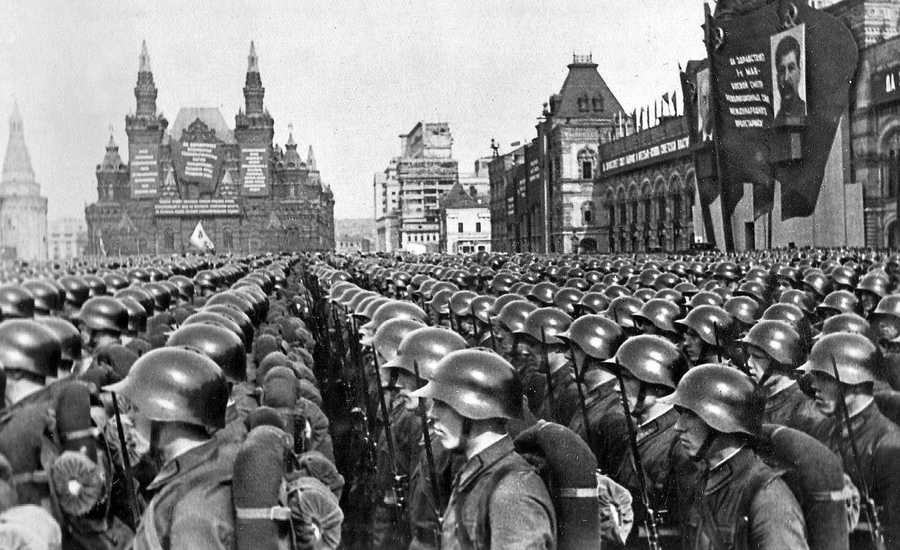
Post-obit the signing of the Molotov-Ribbentrop Pact with Nazi Germany in 1939, the Soviets invaded eastern portions of Poland and fought a war with Finland known as the Wintertime War (1939-40). It was won by the Soviet Union, the aggressor, which gained function of the Karelian Isthmus. Despite Stalin's efforts to stay out of a war against Germany, Federal republic of germany declared war on the Soviet Wedlock and swept across the border on June 22, 1941. By Nov the German language army had seized Ukraine, begun its siege of Leningrad, and threatened to capture Moscow (now the capital letter), itself.
Nevertheless, the Soviet victory at the Boxing of Stalingrad proved decisive, reversing the course of the unabridged state of war. After losing this battle the Germans lacked the strength to sustain their offensive operations confronting the Soviet Union and the Soviet Union held the initiative for the rest of the war. By the end of 1943, the Red Army had broken through the High german siege of Leningrad and recaptured much of Ukraine. By the end of 1944, the front had moved beyond the 1939 Soviet frontiers into Eastern Europe. With a decisive superiority in troops, Soviet forces collection into eastern Germany, capturing Berlin in May 1945. The war with Germany thus ended triumphantly for the Soviet Spousal relationship.
Although the Soviet Union was victorious in Globe War II, its economy had been devastated in the struggle and the war resulted in around 27 million Soviet deaths.
Common cold State of war
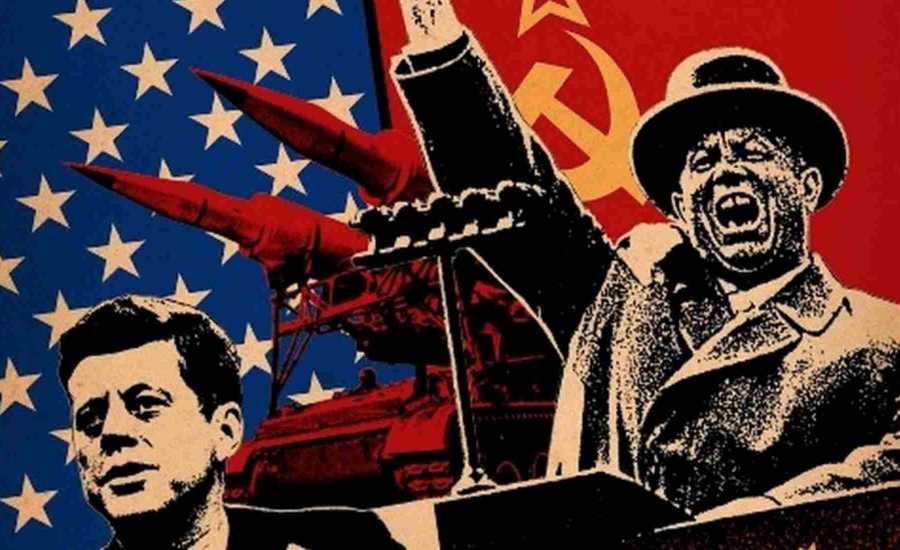
Collaboration amongst the major Allies had won the war and was supposed to serve as the basis for postwar reconstruction and security. However, the conflict between Soviet and U.S. national interests, known as the Cold State of war, came to dominate the international stage in the postwar flow, assuming the public guise equally a clash of ideologies.
The Cold War emerged out of a conflict between Stalin and U.Southward. President Harry Truman over the time to come of Eastern Europe during the Potsdam Briefing in the summer of 1945. Russia had suffered three devastating Western onslaughts in the previous 150 years during the Napoleonic Wars, the Beginning World State of war, and the Second World War, and Stalin's goal was to constitute a buffer zone of states between Frg and the Soviet Marriage. Truman claimed that Stalin had betrayed the Yalta agreement. With Eastern Europe under Ruby Army occupation, Stalin was besides biding his time, as his own atomic bomb project was steadily and secretly progressing.
In April 1949 the U.s. sponsored the North Atlantic Treaty Organization (NATO), a mutual defence pact in which nearly Western nations pledged to care for an armed attack against one nation as an attack on all. The Soviet Union established an Eastern counterpart to NATO in 1955, dubbed the Warsaw Pact. The division of Europe into Western and Soviet blocs later took on a more than global character, especially later on 1949, when the U.S. nuclear monopoly ended with the testing of a Soviet flop and the Communist takeover in China. The foremost objectives of Soviet foreign policy were the maintenance and enhancement of national security and the maintenance of hegemony over Eastern Europe. The Soviet Marriage maintained its dominance over the Warsaw Pact through crushing the 1956 Hungarian Revolution, suppressing the Prague Spring in Czechoslovakia in 1968, and supporting the suppression of the Solidarity movement in Poland in the early 1980s.
Equally the Soviet Matrimony connected to maintain tight control over its sphere of influence in Eastern Europe, the Cold War gave way to Detente and a more complicated blueprint of international relations in which the globe was no longer conspicuously divide into 2 clearly opposed blocs in the 1970s. Less powerful countries had more room to assert their independence, and the ii superpowers were partially able to recognize their mutual interest in trying to check the further spread and proliferation of nuclear weapons in treaties such as Salt I, Common salt II and the Anti-Ballistic Missile Treaty.
U.S. - Soviet relations deteriorated post-obit the Soviet invasion of Transitional islamic state of afghanistan in 1979 and the 1980 election of Ronald Reagan, a staunch anticommunist, merely improved as the Soviet bloc started to unravel in the late 1980s. With the collapse of the Soviet Union in 1991, Russia lost the superpower status that it had won in the 2nd World War.
The Khrushchev and Brezhnev years
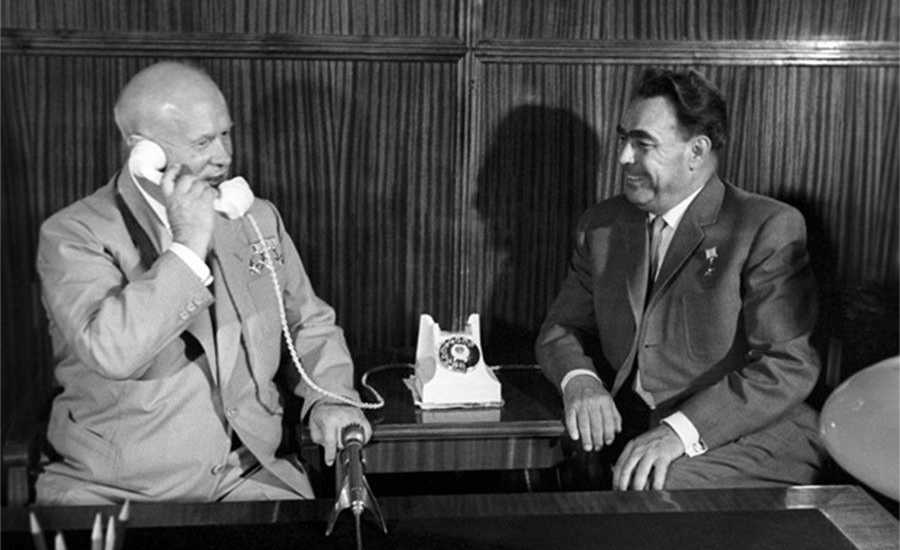
In the power struggle that erupted afterward Stalin'south expiry in 1953, his closest followers lost out. Nikita Khrushchev solidified his position in a speech before the Twentieth Congress of the Communist Political party in 1956 detailing Stalin'southward atrocities and attacking him for promoting a personality cult. Every bit details of his oral communication became public, Khrushchev accelerated a wide range of reforms. Downplaying Stalin'due south emphasis on heavy manufacture, he increased the supply of consumer goods and housing and stimulated agricultural product. The new policies improved the standard of living, although shortages of appliances, clothing, and other consumer durables would increase in later years. The judicial system, albeit yet under a complete Communist political party control, replaced constabulary terror, and intellectuals had more freedom than earlier.
In 1964 Khrushchev was ousted by the Communist Party'due south Key Committee, which charged him with a host of errors that included Soviet setbacks such as the Cuban Missile Crisis and the deepening Sino-Soviet Divide. After a brief period of collective leadership, a veteran bureaucrat, Leonid Brezhnev, took Khrushchev'southward place.
Despite Khrushchev's tinkering with economical planning, the economic organisation remained dependent on key plans drawn upwards with no reference to market mechanisms. As a adult industrial country, the Soviet Wedlock by the 1970s institute information technology increasingly difficult to maintain the loftier rates of growth in the industrial sector that information technology had enjoyed in earlier years. Increasingly large investment and labor inputs were required for growth, but these inputs were condign more than difficult to obtain, partly because of the new emphasis on production of consumer goods. Although the goals of the five-year plans of the 1970s had been scaled down from previous plans, the targets remained largely unmet. Agricultural development continued to lag in the Brezhnev years.
Although certain appliances and other goods became more accessible during the 1960s and 1970s, improvements in housing and nutrient supply were not sufficient. The growing culture of consumerism and a shortage of consumer goods, inherent in a non-market pricing system, encouraged pilferage of regime property and the growth of the black market place. Merely, in contrast to the revolutionary spirit that accompanied the birth of the Soviet Union, the prevailing mood of the Soviet leadership at the time of Brezhnev's death in 1982 was one of aversion to change.
Impending breakup of the Union
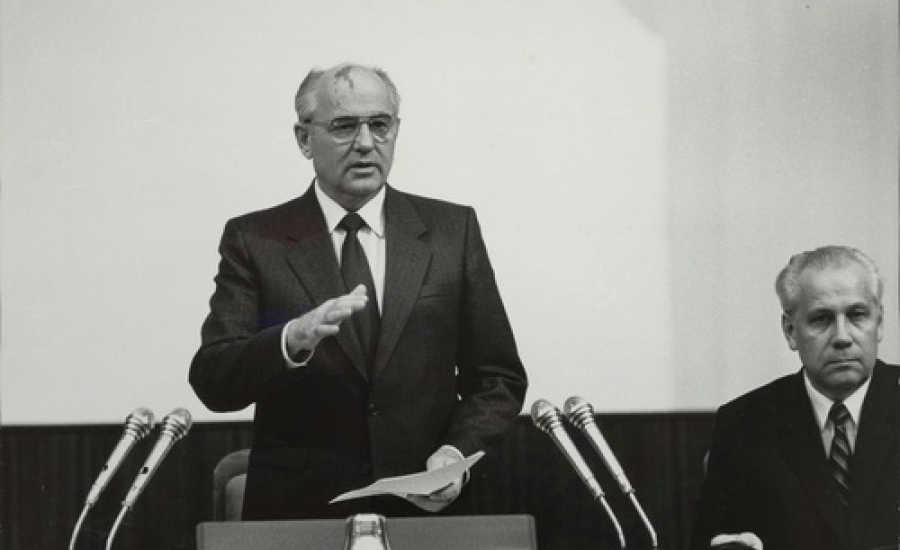
Two developments dominated the decade that followed: the increasingly apparent aging of the Soviet Wedlock'due south economical and political structures, and the patchwork attempts at reforms to reverse that procedure. After the rapid succession of Yuri Andropov and Konstantin Chernenko, transitional figures with deep roots in Brezhnevite tradition, the relatively immature and energetic Mikhail Gorbachev made pregnant changes in the economy and the party leadership. His policy of glasnost freed public access to information afterward decades of government repression. But Gorbachev failed to address the systemic crisis of the Soviet system; by 1991, when a plot by authorities insiders revealed the weakness of Gorbachev's political position, the stop of the Soviet Wedlock was in sight.
At the finish of Globe War I, the vast empires of the Ottomans, the Habsburgs, and the Romanovs collapsed, leaving Eastern Europe and Eurasia in turmoil. Only the Russian empire was reconfigured, under Bolshevik leadership. Stalin led information technology through industrialization and the Nazi onslaught to become a superpower rivaling the United States. Nevertheless the Soviet Union remained essentially an empire, held together by a party rather than tsar. The control economy proved progressively less able to cope with postindustrial technologies and with the demands of the new industrial eye form and well-educated hierarchy forged under its tutelage. Gorbachev's Perestroika spelled deconstruction of the economy; and glasnost allowed indigenous and nationalist disaffection to reach the surface. When Gorbachev tried to reform the party, he weakened the bonds that held the state and union together.
The emergence of the Russian democracy in the Soviet Union
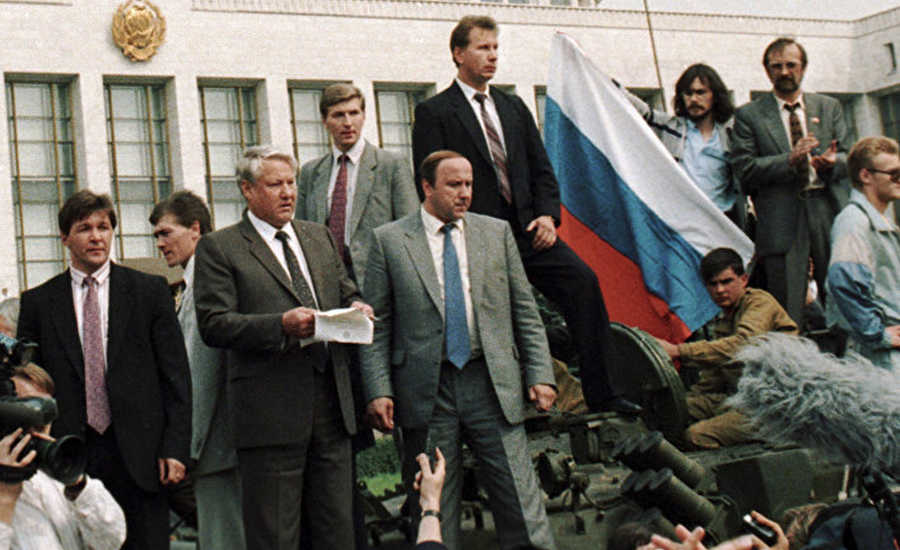
Gorbachev has accused Boris Yeltsin, his old rival and Russia's first post-Soviet president, of vehement the country autonomously out of a desire to accelerate his ain personal interests.
Because of the dominant position of Russians in the Soviet Union, most gave picayune thought to whatsoever distinction between Russia and the USSR before the belatedly 1980s. However, the fact that the Soviet government was dominated by Russians did not mean that the Russian SFSR necessarily benefited from this organisation. In the Soviet Union, Russia lacked even the paltry instruments of statehood that the other republics possessed, such every bit its own republic-level Communist Political party branch, KGB, merchandise wedlock council, Academy of Sciences, and the like. The reason of course is that if these organizations had had branches at the level of the Russian SFSR, they would have threatened the power of Union-level structures.
In the tardily 1980s, Gorbachev underestimated the importance of the Russian Soviet Federative Socialist Commonwealth emerging as a second power base to rival the Soviet Union. A Russian nationalist backfire against the Matrimony came with many Russians arguing that Russian federation had long been subsidizing other republics, which tended to be poorer, with cheap oil, for instance. Demands were growing for Russia to have its own institutions, underdeveloped because of the equation of the Russian republic and the Soviet Wedlock. As Russian nationalism became vocal in the late 1980s, a tension emerged between those who wanted to agree the Russian-dominated Union together and those who wanted to create a strong Russian country.
This tension came to be personified in the bitter power struggle between Gorbachev and Boris Yeltsin. Squeezed out of Marriage politics by Gorbachev in 1987, Yeltsin, an old-style political party boss with no dissident background or contacts, needed an culling platform to challenge Gorbachev. He established it past representing himself as both a Russian nationalist and a committed democrat. In a remarkable reversal of fortunes, he gained election as chairman of the Russian republic'southward new Supreme Soviet in May 1990, becoming in event Russian federation'due south kickoff direct elected president. The following month, he secured legislation giving Russian laws priority over Soviet laws and withholding two-thirds of the upkeep.
The August 1991 coup past Communist hardliners was later foiled with aid from Yeltsin. The insurrection plotters had intended to save the political party and the Union; instead, they hastened the demise of both.
The Soviet Spousal relationship officially broke upwards on December 25, 1991. The last human activity of the passage of ability from the Soviet Union to Russian federation was the passing of the briefcases containing codes that would launch the Soviet nuclear arsenal from Gorbachev to Yeltsin.
Read on to acquire about today'southward Russia.
Source: https://www.expresstorussia.com/experience-russia/soviet-russia.html
0 Response to "The Ussr Will Rise Again in Russian"
إرسال تعليق